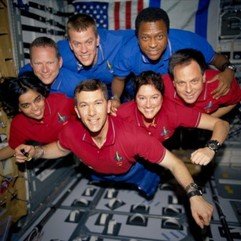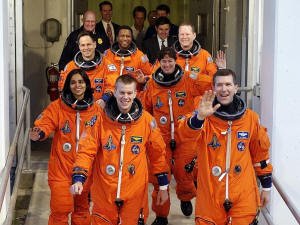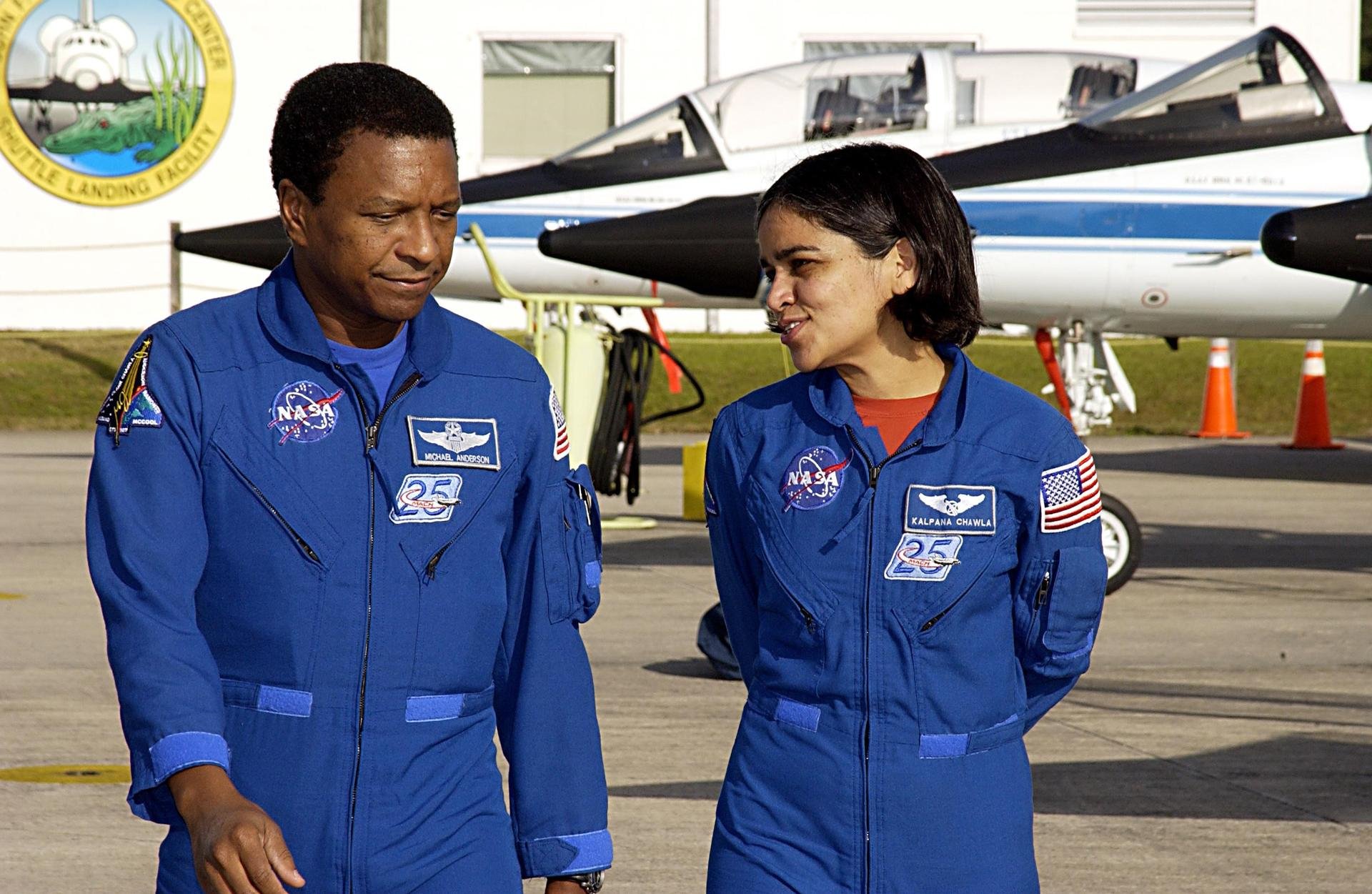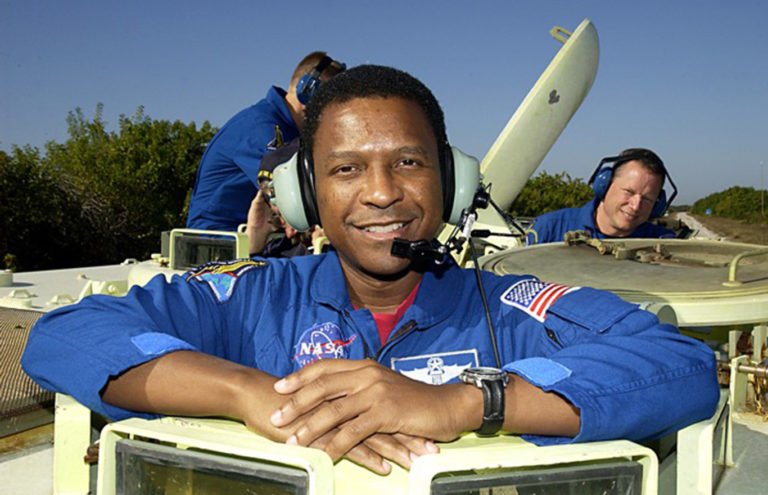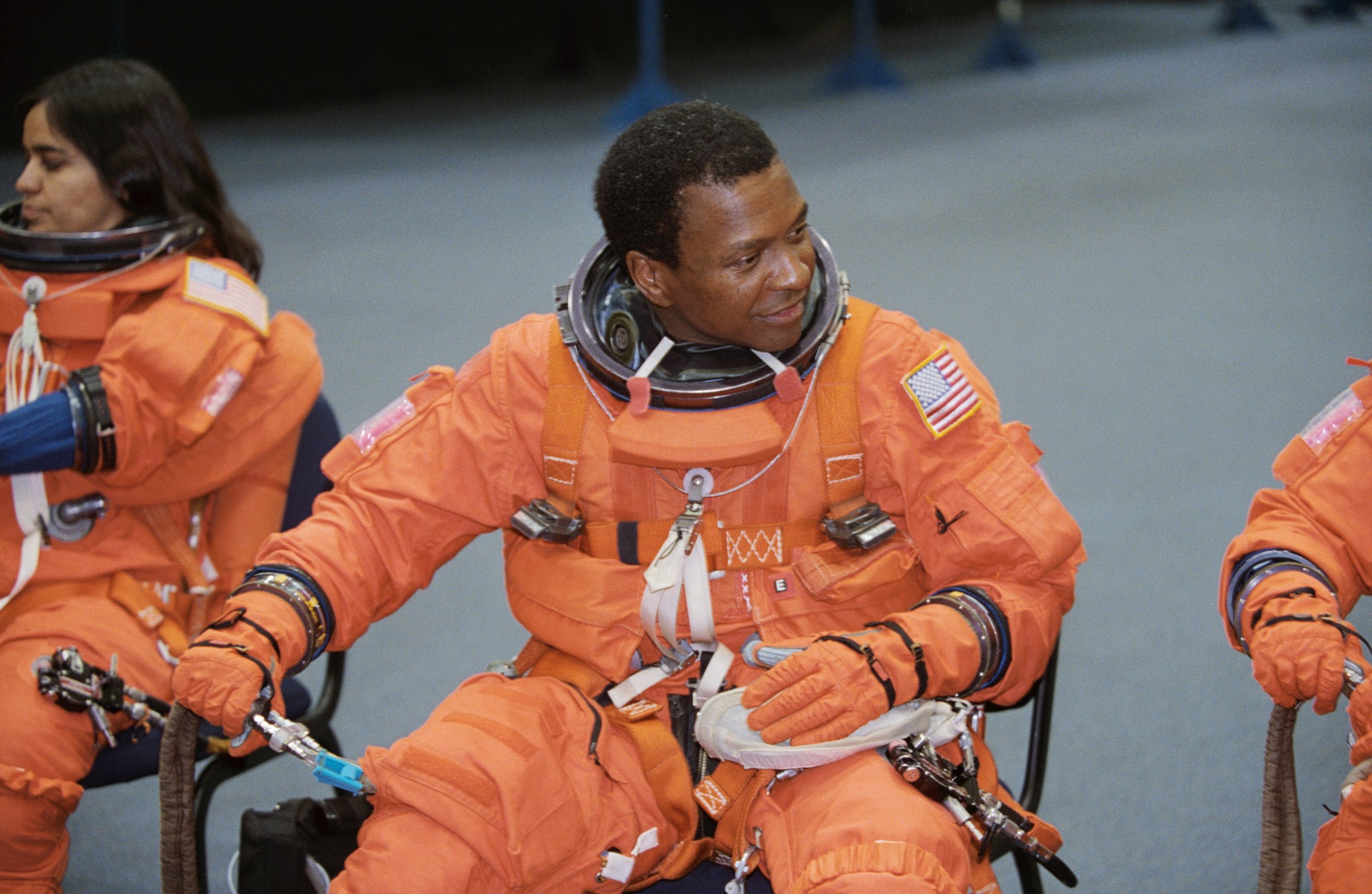Michael P. Anderson
Early life and education
Anderson was born in 1959 to Barbara and Bobbie Anderson; his father serviced jets at Plattsburgh Air Force Base in Plattsburgh, New York.[2] Bobbie Anderson was transferred to Fairchild Air Force Base, about 12 miles away from Spokane, Washington, which Anderson spoke of as his hometown.[3] Anderson graduated from Cheney High School in Cheney, Washington, one of four African Americans in a class of 200 students.[2]
In 1981, Anderson earned a Bachelor of Science degree in physics and astronomy from the University of Washington in Seattle, and in 1990, he was awarded a Master of Science degree in physics from Creighton University in Omaha, Nebraska.[4]
Air Force career
Upon Anderson's graduation from the University of Washington, he was commissioned a second lieutenant in the U.S. Air Force.[2] After completing a year of technical training at Keesler Air Force Base in Mississippi, Anderson was assigned to Randolph Air Force Base in Texas.[2] At Randolph he served as chief of communication maintenance for the 2015th Communication Squadron and later as director of information system maintenance for the 1920th Information System Group.[2]
In 1986, Anderson was selected to attend Undergraduate Pilot Training at Vance Air Force Base, Oklahoma.[2] Upon graduation he was assigned to the 2d Airborne Command and Control Squadron, Offutt Air Force Base, Nebraska as an EC-135 pilot, flying the Strategic Air Command's airborne command post code-named "Looking Glass." He completed his master's degree while stationed at Offutt.[2]
From January 1991 to September 1992, Anderson served as an aircraft commander and instructor pilot in the 920th Air Refueling Squadron, Wurtsmith Air Force Base, Michigan.[2] From September 1992 to February 1995, he was assigned as an instructor pilot and tactics officer in the 380th Air Refueling Wing, Plattsburgh Air Force Base, New York.[2]
Anderson had logged more than 3,000 hours of flight time when NASA selected him for astronaut training in December 1994.[2] He was one of 19 candidates selected from a pool of 2,962 applicants.[2]
Special honors[3]
Distinguished graduate, USAF Communication Electronics Officers course
The Armed Forces Communication Electronics Associations Academic Excellence Award
Undergraduate Pilot Training Academic Achievement Award for Class 87-08 Vance AFB
NASA
Anderson reported to the Johnson Space Center in March 1995.[2] He completed a year of training and evaluation, and was qualified for flight crew assignment as a mission specialist.[2] Anderson was initially assigned technical duties in the Flight Support Branch of the Astronaut Office, but went on to log more than 593 hours in space aboard two Space Shuttle missions.[2]
Space Shuttle missions
Endeavour
STS-89 Endeavour (January 22–31, 1998). Anderson was a mission specialist on STS-89, the eighth Shuttle-to-Mir Space Station docking mission, during which the crew delivered more than 9,000 pounds of scientific equipment, logistical hardware, and water.
In the fifth and last exchange of a U.S. astronaut, STS-89 delivered Andy Thomas to Mir and returned with David Wolf. The mission's duration was 8 days, 19 hours, and 47 seconds, traveling 3.6 million miles in 138 orbits of the Earth.[3]
Columbia
During STS-107, Anderson served as payload commander and lieutenant colonel in charge of science experiments on the Space Shuttle Columbia, NASA's oldest shuttle.[5] On February 1, 2003, the shuttle was returning to Earth after a successful 16-day trip to orbit, where the crew had conducted more than 80 scientific experiments.[6]
Unbeknownst to her crew, the orbiter had suffered critical damage during its launch on January 16, when foam from the fuel tank's insulation fell off and tore a hole in Columbia's left wing.[7] During re-entry, the hole allowed super-hot atmospheric gases to penetrate the orbiter's wing, leading to its destruction.[7] The mission's duration was 15 days, 22 hours, and 20 minutes.
The Columbia Accident Investigation Board reported[8] that, in addition to the Columbia's physical damage, NASA's management culture was partly responsible for the disaster.[9]
Quotes
Prior to the final launch of the Columbia, Anderson told reporters: "There's always that unknown."[1]
Personal life
Anderson was survived by his wife, Sandra Hawkins, and two daughters, Kaycee and Sydney. He was also survived by his parents and three sisters.[10] Anderson was buried at Arlington National Cemetery.
Anderson and his family lived in Houston at the time of his death, where they attended Grace Community Church.[11] Anderson sang tenor in the church's choir.[11]
Awards
Air Force Command Pilot Astronaut badge Defense Distinguished Service Medal † Defense Superior Service Medal Meritorious Service Medal Air Force Achievement Medal with cluster National Defense Service Medal Congressional Space Medal of Honor † NASA Distinguished Service Medal † NASA Space Flight Medal † The † symbol indicates a posthumous award.
Legacy and tributes
Lt. Col. Michael P. Anderson.
State Route 904, running through Cheney, Washington, where Anderson graduated from high school, was renamed in his memory.
The science and math wing of Cheney High School is dedicated to Anderson.
Asteroid 51824 Mikeanderson was posthumously named after Anderson.
Anderson Hall, in the Columbia Village apartments at the Florida Institute of Technology is named after him.
Anderson Plaza, the green space in front of the Hixson-Lied Science Center at Creighton University was named after him in a compromise between the student body, who wanted the Science Center named for Anderson, and the administration who had already sold the naming rights to the Hixson-Lied family.
Blair Elementary School on Fairchild Air Force Base in Washington was renamed Michael Anderson Elementary School in January 2004. He attended the school as a fifth-grader.[12]
Avondale Elementary School in Avondale, Arizona was renamed Michael Anderson Elementary in his honor. He attended school there when he was in the third grade, and one of the school T-shirts was aboard the Columbia on its last voyage.
In 2003, Anderson was inducted into the International Forest of Friendship, in Atchison, KS as part of a memorial to the Columbia astronauts.[13]
Anderson Park in Canton, Mississippi was dedicated in June 2004.
An outdoor bronze statue of Anderson was unveiled in Spokane in June 2005. Larger-than-life, it was created by local artist Dorothy Fowler, and shows Anderson kneeling with his helmet in one hand and a dove in the other.[14][15]
A duplicate statue was dedicated at the Museum of Flight in Seattle in June 2009[16] and the museum launched an aerospace program in his honor.[17]
An outdoor mural in the city of Plattsburgh was unveiled in October 2020 honoring Anderson. On July 4, 2021, the city of Plattsburgh held a dedication for the mural, where the Anderson family was given a key to the city and led the annual Independence Day parade.
Lunar crater M. Anderson is named after him.[18]
The Creighton University Physics Department, from which Anderson received his master's degree, maintains a statue and physics scholarship in his honor.[19][20]
Lieutenant Colonel Anderson was an instructor pilot and tactics officer in the U.S. Air Force. Anderson is the recipient of many awards and honors, some of which include the Defense Superior Service Medal, the USAF Meritorious Service Medal and the USAF Achievement Medal with one oak leaf cluster.
Michael Anderson became an astronaut in 1995 and qualified for flight crew assignment as a mission specialist. He flew on Endeavour STS-89, the eighth Shuttle Mir docking mission. He has logged over 593 hours in space.
Anderson served as a mission specialist on Columbia STS-107. The mission ended abruptly when space shuttle Columbia and its crew perished during entry, 16 minutes before its scheduled landing.
Michael P. Anderson made the ultimate sacrifice and lost his life in service to the national and the space program on February 1, 2003 at 43 years of age.
About Space Shuttle Columbia
Space Shuttle Columbia (OV-102) was a Space Shuttle orbiter manufactured by Rockwell International and operated by NASA. Named after the first American ship to circumnavigate the upper North American Pacific coast and the female personification of the United States, Columbia was the first of five Space Shuttle orbiters to fly in space, debuting the Space Shuttle launch vehicle on its maiden flight in April 1981. As only the second full-scale orbiter to be manufactured after the Approach and Landing Test vehicle Enterprise, Columbia retained unique features indicative of its experimental design compared to later orbiters, such as test instrumentation and distinctive black chines. In addition to a heavier fuselage and the retention of an internal airlock throughout its lifetime, these made Columbia the heaviest of the five spacefaring orbiters; around 1,000 kilograms (2,200 pounds) heavier than Challenger and 3,600 kilograms (7,900 pounds) heavier than Endeavour. Columbia also carried ejection seats based on those from the SR-71 during its first six flights until 1983, and from 1986 onwards carried an imaging pod on its vertical stabilizer.
During its 22 years of operation, Columbia was flown on 28 missions in the Space Shuttle program, spending over 300 days in space and completing over 4,000 orbits around Earth. While it was seldom used after completing its objective of testing the Space Shuttle system, and its heavier mass and internal airlock made it less than ideal for planned Shuttle-Centaur launches and dockings with space stations, it nonetheless proved useful as a workhorse for scientific research in orbit following the loss of Challenger in 1986. Columbia was used for eleven of the fifteen flights of Spacelab laboratories, all four United States Microgravity Payload missions, and the only flight of Spacehab's Research Double Module. The Extended Duration Orbiter pallet was used by the orbiter in thirteen of the pallet's fourteen flights, which aided lengthy stays in orbit for scientific and technological research missions. Columbia was also used to retrieve the Long Duration Exposure Facility and deploy the Chandra observatory, and also carried into space the first female commander of an American spaceflight mission, the first ESA astronaut, the first female astronaut of Indian origin, and the first Israeli astronaut.
At the end of its final flight in February 2003, Columbia disintegrated upon reentry, killing the seven-member crew of STS-107 and destroying most of the scientific payloads aboard. The Columbia Accident Investigation Board convened shortly afterwards concluded that damage sustained to the orbiter's left wing during the launch of STS-107 fatally compromised the vehicle's thermal protection system. The loss of Columbia and its crew led to a refocusing of NASA's human exploration programs and led to the establishment of the Constellation program in 2005 and the eventual retirement of the Space Shuttle program in 2011. Numerous memorials and dedications were made to honor the crew following the disaster; the Columbia Memorial Space Center was opened as a national memorial for the accident, and the Columbia Hills in Mars' Gusev crater, which the Spirit rover explored, were named after the crew. The majority of Columbia's recovered remains are stored at the Kennedy Space Center's Vehicle Assembly Building, though some pieces are on public display at the nearby Visitor Complex.

